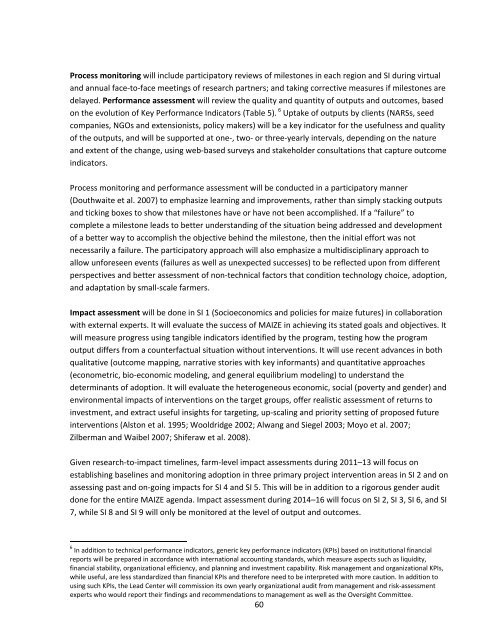Download - Maize
Download - Maize
Download - Maize
Create successful ePaper yourself
Turn your PDF publications into a flip-book with our unique Google optimized e-Paper software.
Process monitoring will include participatory reviews of milestones in each region and SI during virtual<br />
and annual face‐to‐face meetings of research partners; and taking corrective measures if milestones are<br />
delayed. Performance assessment will review the quality and quantity of outputs and outcomes, based<br />
on the evolution of Key Performance Indicators (Table 5). 6 Uptake of outputs by clients (NARSs, seed<br />
companies, NGOs and extensionists, policy makers) will be a key indicator for the usefulness and quality<br />
of the outputs, and will be supported at one‐, two‐ or three‐yearly intervals, depending on the nature<br />
and extent of the change, using web‐based surveys and stakeholder consultations that capture outcome<br />
indicators.<br />
Process monitoring and performance assessment will be conducted in a participatory manner<br />
(Douthwaite et al. 2007) to emphasize learning and improvements, rather than simply stacking outputs<br />
and ticking boxes to show that milestones have or have not been accomplished. If a “failure” to<br />
complete a milestone leads to better understanding of the situation being addressed and development<br />
of a better way to accomplish the objective behind the milestone, then the initial effort was not<br />
necessarily a failure. The participatory approach will also emphasize a multidisciplinary approach to<br />
allow unforeseen events (failures as well as unexpected successes) to be reflected upon from different<br />
perspectives and better assessment of non‐technical factors that condition technology choice, adoption,<br />
and adaptation by small‐scale farmers.<br />
Impact assessment will be done in SI 1 (Socioeconomics and policies for maize futures) in collaboration<br />
with external experts. It will evaluate the success of MAIZE in achieving its stated goals and objectives. It<br />
will measure progress using tangible indicators identified by the program, testing how the program<br />
output differs from a counterfactual situation without interventions. It will use recent advances in both<br />
qualitative (outcome mapping, narrative stories with key informants) and quantitative approaches<br />
(econometric, bio‐economic modeling, and general equilibrium modeling) to understand the<br />
determinants of adoption. It will evaluate the heterogeneous economic, social (poverty and gender) and<br />
environmental impacts of interventions on the target groups, offer realistic assessment of returns to<br />
investment, and extract useful insights for targeting, up‐scaling and priority setting of proposed future<br />
interventions (Alston et al. 1995; Wooldridge 2002; Alwang and Siegel 2003; Moyo et al. 2007;<br />
Zilberman and Waibel 2007; Shiferaw et al. 2008).<br />
Given research‐to‐impact timelines, farm‐level impact assessments during 2011–13 will focus on<br />
establishing baselines and monitoring adoption in three primary project intervention areas in SI 2 and on<br />
assessing past and on‐going impacts for SI 4 and SI 5. This will be in addition to a rigorous gender audit<br />
done for the entire MAIZE agenda. Impact assessment during 2014–16 will focus on SI 2, SI 3, SI 6, and SI<br />
7, while SI 8 and SI 9 will only be monitored at the level of output and outcomes.<br />
6 In addition to technical performance indicators, generic key performance indicators (KPIs) based on institutional financial<br />
reports will be prepared in accordance with international accounting standards, which measure aspects such as liquidity,<br />
financial stability, organizational efficiency, and planning and investment capability. Risk management and organizational KPIs,<br />
while useful, are less standardized than financial KPIs and therefore need to be interpreted with more caution. In addition to<br />
using such KPIs, the Lead Center will commission its own yearly organizational audit from management and risk‐assessment<br />
experts who would report their findings and recommendations to management as well as the Oversight Committee.<br />
60

















